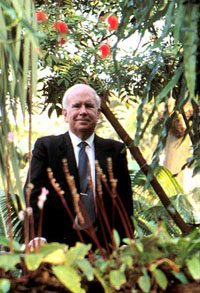 |
QUICK SEARCH
MO PROJECTS:
Africa
Asia/Pacific
Mesoamerica
North America
South America
General Taxonomy
Photo Essays
Training in Latin
America
MO RESEARCH:
Wm. L. Brown Center
Bryology
GIS
Graduate Studies
Research Experiences
for Undergraduates
Imaging Lab
Library
MBG Press
Publications
Climate Change
Catalog Fossil Plants
MO DATABASES:
W³MOST
Image Index
Rare Books
Angiosperm
Phylogeny
Res Botanica
All Databases
INFORMATION:
What's New?
People at MO
Visitor's Guide
Herbarium
Jobs & Fellowships
Symposium
Research Links
Site Map
Search
 |
table of contents |

|

| |
In 1859, Charles Darwin published his watershed work On the Origin of Species - the same year the Missouri Botanical Garden opened to the public. Darwin opened the door to a new era of scientific discovery, and the Garden has become a world leader in systematics - the study of plants and their evolution.
In the 19th century, the wondrous diversity of nature must have seemed limitless. Just over a century later, the first photograph from outer space revealed our world as it is - a small and finite planet. Today it is a world where a third of our forests have been cut, a quarter of our topsoil is gone, and plants and animals are disappearing faster than we can learn about them, or even know what is gone.
Plants are absolutely essential to sustaining the stability and quality of human life on this planet. Their loss threatens the future of our children and our grandchildren.
At the Missouri Botanical Garden, we have dedicated ourselves to helping conserve biological diversity while there is still something left to protect. Our research provides scientific information essential to decision makers, from conservation and land use to social and environmental policy. We have taken the lead in making information widely accessible via the Internet, maintaining the world's largest botanical database and the premier botanical website.
Our scientists are among the best at gathering, identifying, and classifying plants and contributing to the understanding of their place in the global ecosystem. In 1971 there were just three Ph.D. botanists at the Garden; today there are nearly 50. The Research Division maintains or participates in some 25 floristic projects and sends expeditions to investigate ecosystems in over 30 countries around the globe. With assistance from 75 technical and support personnel, over 30 graduate students from more than 15 countries, and 70 volunteers. Garden scientists conduct the most productive and geographically widespread botanical research program in the world.
The number of species threatened with extinction is large, the resources to identify them and understand them are small - and time is short. The Garden works to expedite conservation and sustainable development in countries where our scientists are active, and we are developing a dynamic program in conservation biology, an exciting prospect for the future.
At the Missouri Botanical Garden, we are striving for a world that can sustain us without sacrificing prosperity for future generations, a world where all people share a commitment to manage biological diversity for our common benefit. The Unseen Garden is a story of hope and promise - the story of dedicated people working to make that goal a reality.
-Peter H. Raven
|
||
| Text and photos from "The Unseen Garden" available from MBG Press. | ||
© 1995-2025 Missouri Botanical Garden, All Rights Reserved
4344 Shaw Blvd.
St. Louis, MO 63110
(314) 577-5100
Technical Support